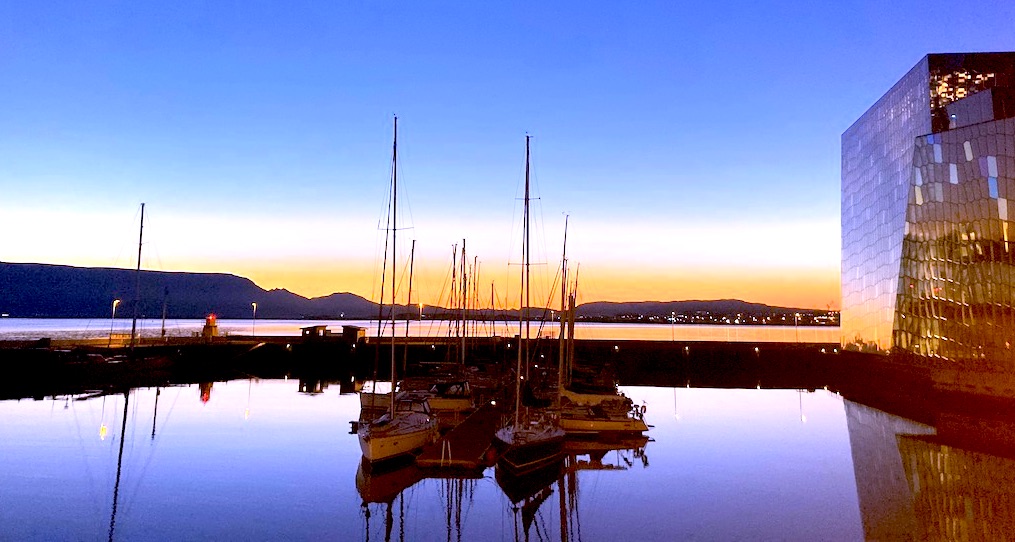Paris. Madrid. Berlin. The capitals of Europe are among the great cities of the world. Reykjavik… is not that. It’s a different sort of place entirely. For many visitors Iceland’s capital is something of an afterthought. It can be a box to tick on the way to see volcanoes, geothermal pools and the elusive Northern Lights.
But Reykjavik is a charming and historic city where most tourists should feel right at home. While Iceland is highly dependent on tourism, it doesn’t suffer the effects of overtourism. At least, not in Reykjavik in the post-Covid era. Tourists and locals mix effortlessly.

Where’s the Money? This site may contain affiliate links. Many travel sites include such links to earn a commission at no cost to readers.
Getting to Reykjavik
A key reason Iceland is such a popular destination is the fact that it’s easy and economical to reach by air from both the US and Europe. Even in the high Summer season Skyscanner is showing round-trip flights from Boston, NYC and Washington for $360. There’s competition among US carriers on Icelandic routes as well as discount deals from the likes of Play Air. But the country has its own national carrier and their free stopover program is one of the most popular ways to arrive in Reykjavik. Even though it’s not much longer than a flight across the US, the trip to Reykjavik will be a redeye flight.
Being halfway to Europe makes Reykjavik an ideal choice for a stopover. Having the flexibility to stay up to 7 days lets visitors plan a trip that’s perfect for them. Taking a look at Viator’s Iceland attractions can give you a good idea of what to see outside the city. It’s also very handy for comparing the cost of seeing Iceland’s natural wonders on an organized excursion vs. renting a car.

Should You Rent a Car in Reykjavik?
Iceland is sometimes thought of as a cheap destination because of the competitive prices for flights and a number of hostels in the capital. But aside from the airfare nothing in Iceland is cheap. It’s a remote island that has to have nearly everything imported meaning the cost of living is unusually high, including rental cars.
If your aim is to get outside the city and see the Golden Circle or Blue Lagoon a car is extremely convenient. But small SUV’s go for around $125-150 a day. If you’re staying a week that can add $1000 to your total cost. That’s before you account for buying gas and parking. Many Reykjavik hotels don’t offer on-site parking, leaving guests to depend on street spaces or private facilities. Fortunately you can usually park overnight for free but during the day parking is charged by the hour. It can add up quickly and be hard to know the total before you park.
Reykjavik doesn’t sprawl so space is at a premium. Many streets in the center of town are closed to traffic permanently. While a car is convenient for getting out of town, it can be a burden to have in the city where everything is walkable.
Ultimately the deciding factor in whether to rent a car is how long you’re staying and how many are in your traveling party. If there are more than 3 people to split the cost or you’re only staying two days a car may be a good value. For a solo traveler a package tour including transportation and site admissions might make more sense.
Where and When to Stay
On the map above the area between the port and Tjornin Pond is downtown. This is where you’ll find parliament, the prime minister’s residence, and various government buildings. There’s also a number of hotels and plazas here. East of downtown out to Hlemmur is what you might think of as “Midtown.” The area has lots of shops and restaurants on pedestrianized streets. It’s also very popular with visitors.
SEARCH THE MAP: Find Rates in the perfect location at Hotels.com
Reykjavik is so small that the choice of where to stay sort of begins and ends with these two neighborhoods. It doesn’t matter which one you pick. They’re similar and most visitors will be walking freely between them while they’re in town.
Ultimately your own budget and requirements will narrow down your choices. We’d all love to stay at the Edition right in the center of town but it’s $1000 a night. A guesthouse or apartment will be a better option for most visitors.
When you visit has a lot to do with how much you’ll pay. Iceland is cold. It’s cold all the time. You won’t even want to think about coming in January or February. But the prices in the first week of September are half of what they are in August. This is the ideal time to visit on a stopover, when it’s barely autumn and the Riviera is as mild as ever in Europe. Planning your stopover to happen during the week is also a big cost-saver.


Reykjavik Attractions
If your stopover or long weekend trip is focused on the city and not concerned with going out into the countryside it isn’t necessary to do much (or any) planning. It’s just a matter of walking around town and seeing what appeals to you most.
An obvious stop for all visitors is the Hallgrímskirkja Church. Built at the top of a hill overlooking central Reykjavik and its harbor, Hallgrímskirkja is an active Lutheran church in addition to being a prominent national symbol and attraction. Although its impressive design is timeless it was only completed in 1986. As you can see by the scaffolding in the photo above its newness doesn’t prevent it from needing ongoing maintenance.
The church is the ideal sort of attraction because you can pop in for just a moment and grab a photo, or spend time exploring the grounds, hearing music played on the impressive pipe organ or going to the top of the tower. At only $10 a trip to the top is a bargain in this expensive country.
If you’re staying 3 days or more the Reykjavik City Card is a crucial acquisition. For $70 visitors get access to 23 different attractions and free transit rides during their stay. The card is good for 72 hours. Once activated it grans admission to sites like the Settlement Museum, National Gallery, Maritime Museum, and a collection of public thermal baths. That’s right: you don’t need to drive out to a volcano to get the spa treatment.
If you’re the sort of traveler who is interested in history and culture the City Card is almost a no-brainer. It’s not hard at all to make it pay for itself and deliver excess value.


Eating and Drinking in Iceland
The Lebowski Bar is a must on any visit to Reykjavik. Inspired by the film, the decor and menu here absolutely nail it. Inspiration is drawn not just from the film itself, but from bowling alleys generally, Vintage LA, and a chilled out back porch. Burgers and White Russians are the order of the day and at night the place stays lively with programming like DJ’s and trivia nights. Lebowski Bar is quite popular and well loved by locals and tourists alike but it’s not the sort of place you need to wait to be seated or can’t find room at the bar.
Reykjavik is the land of the $10 beer. There’s no getting around it. But most of the beers on offer are craft brewed varieties either from local brewers or from Europe. The custom of not tipping provides a little relief. Einstok Bar was easily my favorite for people watching and downtown’s Lemmy is sort of like Cheers for aging hipsters (in a good way). These are places I’d be in four times a week if they were in my city.
The food in Reykjavik is fantastic. In the arctic climate many places lean into comfort dishes. There’s a lot of pasta and roasted meats, fish and chips, soup in bread bowls, things of that nature. I took a date to the bottomless brunch at Bastard and it was the best brunch spot I’ve ever tried. They just continually drop small plates and beers for two solid hours and everything is gourmet quality. A good travel credit card will serve you well. I was in town more than a week and never touched a Kroner. Everyone in town takes cards.

Reykjavik’s Small Town Feel
At the end of my first day in town I found a copy of Reykjavik Grapevine. Picking up the local alt-weekly in print is easily the number one travel tip for any city. As luck would have it it was their annual Best of The City issue. Looking it over online is a great place to start if you want recommendations from locals. After just a day I’d already found several of the ‘Bests.’ One of a small city’s virtues is that it doesn’t take weeks or months to discover your place in it.
Unsurprisingly, outerwear is a big deal in Iceland. If you’re planning to explore the island outdoors or just want a high quality souvenir that doesn’t scream cheap and tacky one of the first things you should do is check out 66 North or Zo-On.
After a few days when you find yourself strolling down Laugavegur in a new down jacket and recognizing the staff at your new favorite bar, you might be tempted to daydream about joining the Hildurs and the Ingers and becoming a Reykvíkingar someday.


























